Investigating Fonterra Yoghurt Consumer Habits: VR Test Store Research
VerifiedAdded on 2022/01/19
|9
|2152
|39
Project
AI Summary
This research proposal outlines a study investigating Fonterra yoghurt consumer behavior using a virtual reality (VR) test store. The study aims to understand the impact of product positioning, pricing, size, branding, labeling, and packaging on consumer preferences. The research will employ a causal design and experimental design, utilizing a VR environment to simulate consumer shopping experiences and a control group observing real-world supermarket behavior. The research will involve 100 participants, with 80 using the VR test store and 20 in the control group, to analyze the role of emotional and cognitive constructs in purchasing habits. The expected outcome is that marketing strategies related to product presentation significantly influence consumer choices. The proposal includes a detailed budget, timeframe, and ethical considerations, emphasizing data privacy and transparency. The study's findings are intended to provide insights into how Fonterra can improve its marketing strategies to enhance consumer appeal and market share, especially in the New Zealand market.
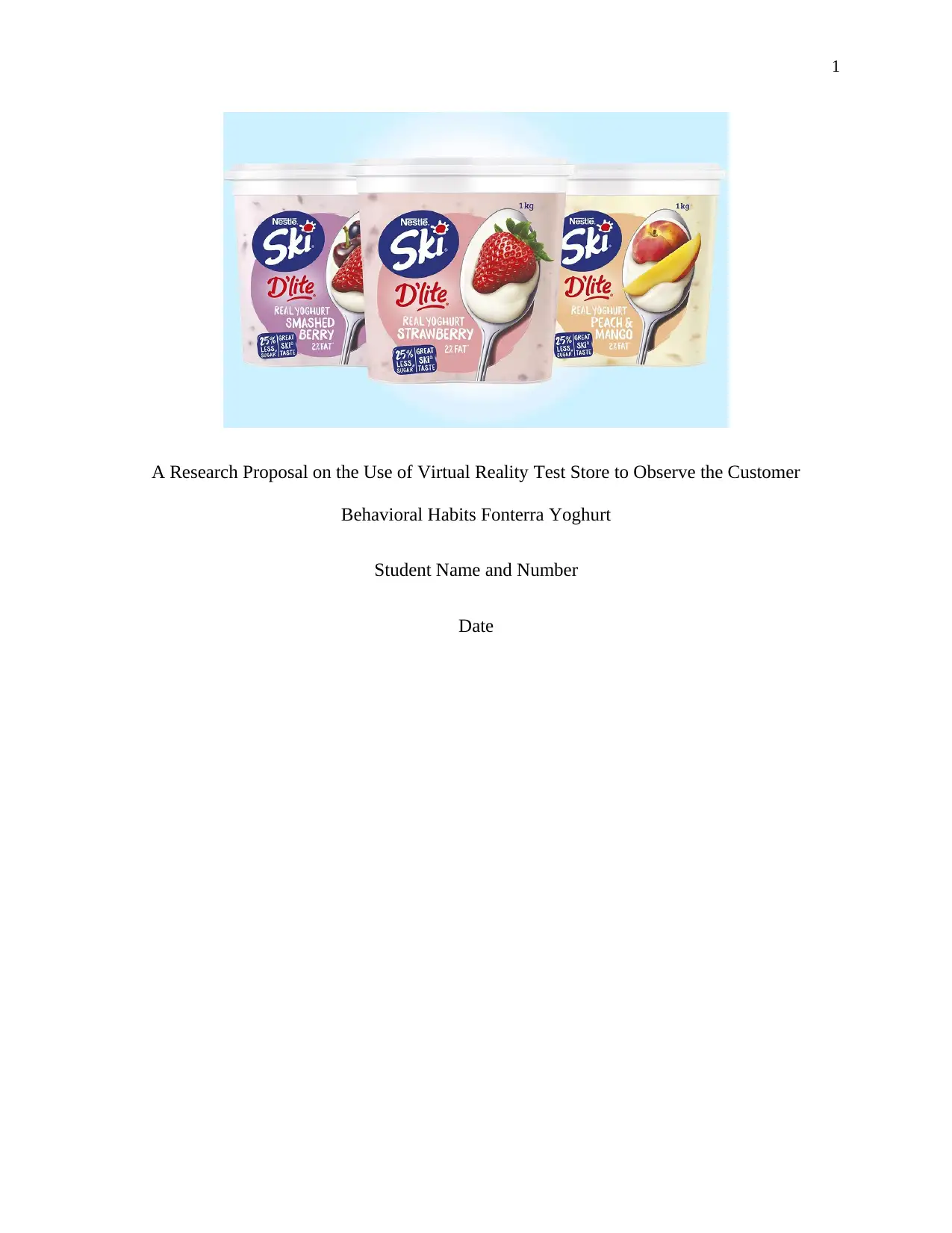
1
A Research Proposal on the Use of Virtual Reality Test Store to Observe the Customer
Behavioral Habits Fonterra Yoghurt
Student Name and Number
Date
A Research Proposal on the Use of Virtual Reality Test Store to Observe the Customer
Behavioral Habits Fonterra Yoghurt
Student Name and Number
Date
Paraphrase This Document
Need a fresh take? Get an instant paraphrase of this document with our AI Paraphraser
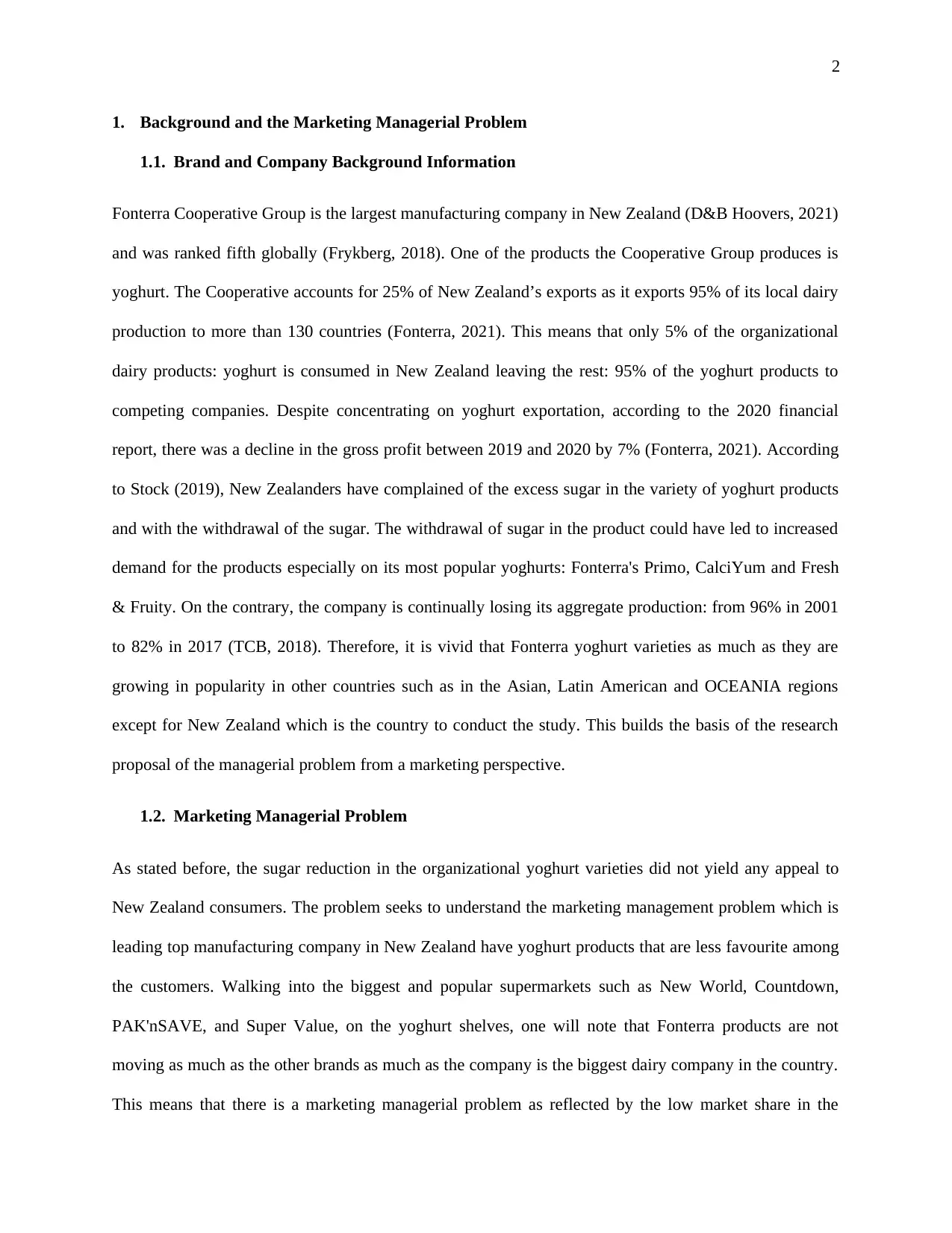
2
1. Background and the Marketing Managerial Problem
1.1. Brand and Company Background Information
Fonterra Cooperative Group is the largest manufacturing company in New Zealand (D&B Hoovers, 2021)
and was ranked fifth globally (Frykberg, 2018). One of the products the Cooperative Group produces is
yoghurt. The Cooperative accounts for 25% of New Zealand’s exports as it exports 95% of its local dairy
production to more than 130 countries (Fonterra, 2021). This means that only 5% of the organizational
dairy products: yoghurt is consumed in New Zealand leaving the rest: 95% of the yoghurt products to
competing companies. Despite concentrating on yoghurt exportation, according to the 2020 financial
report, there was a decline in the gross profit between 2019 and 2020 by 7% (Fonterra, 2021). According
to Stock (2019), New Zealanders have complained of the excess sugar in the variety of yoghurt products
and with the withdrawal of the sugar. The withdrawal of sugar in the product could have led to increased
demand for the products especially on its most popular yoghurts: Fonterra's Primo, CalciYum and Fresh
& Fruity. On the contrary, the company is continually losing its aggregate production: from 96% in 2001
to 82% in 2017 (TCB, 2018). Therefore, it is vivid that Fonterra yoghurt varieties as much as they are
growing in popularity in other countries such as in the Asian, Latin American and OCEANIA regions
except for New Zealand which is the country to conduct the study. This builds the basis of the research
proposal of the managerial problem from a marketing perspective.
1.2. Marketing Managerial Problem
As stated before, the sugar reduction in the organizational yoghurt varieties did not yield any appeal to
New Zealand consumers. The problem seeks to understand the marketing management problem which is
leading top manufacturing company in New Zealand have yoghurt products that are less favourite among
the customers. Walking into the biggest and popular supermarkets such as New World, Countdown,
PAK'nSAVE, and Super Value, on the yoghurt shelves, one will note that Fonterra products are not
moving as much as the other brands as much as the company is the biggest dairy company in the country.
This means that there is a marketing managerial problem as reflected by the low market share in the
1. Background and the Marketing Managerial Problem
1.1. Brand and Company Background Information
Fonterra Cooperative Group is the largest manufacturing company in New Zealand (D&B Hoovers, 2021)
and was ranked fifth globally (Frykberg, 2018). One of the products the Cooperative Group produces is
yoghurt. The Cooperative accounts for 25% of New Zealand’s exports as it exports 95% of its local dairy
production to more than 130 countries (Fonterra, 2021). This means that only 5% of the organizational
dairy products: yoghurt is consumed in New Zealand leaving the rest: 95% of the yoghurt products to
competing companies. Despite concentrating on yoghurt exportation, according to the 2020 financial
report, there was a decline in the gross profit between 2019 and 2020 by 7% (Fonterra, 2021). According
to Stock (2019), New Zealanders have complained of the excess sugar in the variety of yoghurt products
and with the withdrawal of the sugar. The withdrawal of sugar in the product could have led to increased
demand for the products especially on its most popular yoghurts: Fonterra's Primo, CalciYum and Fresh
& Fruity. On the contrary, the company is continually losing its aggregate production: from 96% in 2001
to 82% in 2017 (TCB, 2018). Therefore, it is vivid that Fonterra yoghurt varieties as much as they are
growing in popularity in other countries such as in the Asian, Latin American and OCEANIA regions
except for New Zealand which is the country to conduct the study. This builds the basis of the research
proposal of the managerial problem from a marketing perspective.
1.2. Marketing Managerial Problem
As stated before, the sugar reduction in the organizational yoghurt varieties did not yield any appeal to
New Zealand consumers. The problem seeks to understand the marketing management problem which is
leading top manufacturing company in New Zealand have yoghurt products that are less favourite among
the customers. Walking into the biggest and popular supermarkets such as New World, Countdown,
PAK'nSAVE, and Super Value, on the yoghurt shelves, one will note that Fonterra products are not
moving as much as the other brands as much as the company is the biggest dairy company in the country.
This means that there is a marketing managerial problem as reflected by the low market share in the
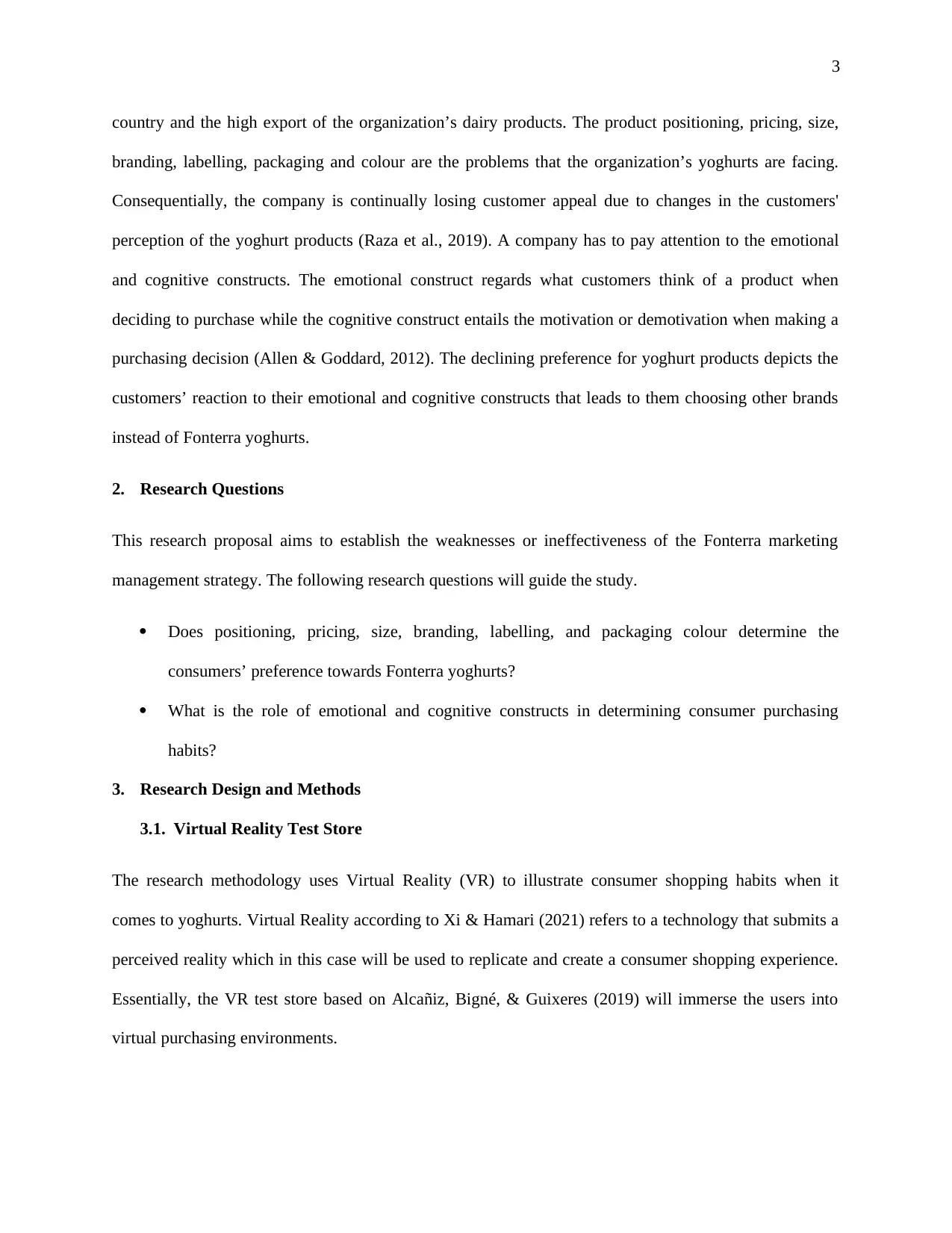
3
country and the high export of the organization’s dairy products. The product positioning, pricing, size,
branding, labelling, packaging and colour are the problems that the organization’s yoghurts are facing.
Consequentially, the company is continually losing customer appeal due to changes in the customers'
perception of the yoghurt products (Raza et al., 2019). A company has to pay attention to the emotional
and cognitive constructs. The emotional construct regards what customers think of a product when
deciding to purchase while the cognitive construct entails the motivation or demotivation when making a
purchasing decision (Allen & Goddard, 2012). The declining preference for yoghurt products depicts the
customers’ reaction to their emotional and cognitive constructs that leads to them choosing other brands
instead of Fonterra yoghurts.
2. Research Questions
This research proposal aims to establish the weaknesses or ineffectiveness of the Fonterra marketing
management strategy. The following research questions will guide the study.
Does positioning, pricing, size, branding, labelling, and packaging colour determine the
consumers’ preference towards Fonterra yoghurts?
What is the role of emotional and cognitive constructs in determining consumer purchasing
habits?
3. Research Design and Methods
3.1. Virtual Reality Test Store
The research methodology uses Virtual Reality (VR) to illustrate consumer shopping habits when it
comes to yoghurts. Virtual Reality according to Xi & Hamari (2021) refers to a technology that submits a
perceived reality which in this case will be used to replicate and create a consumer shopping experience.
Essentially, the VR test store based on Alcañiz, Bigné, & Guixeres (2019) will immerse the users into
virtual purchasing environments.
country and the high export of the organization’s dairy products. The product positioning, pricing, size,
branding, labelling, packaging and colour are the problems that the organization’s yoghurts are facing.
Consequentially, the company is continually losing customer appeal due to changes in the customers'
perception of the yoghurt products (Raza et al., 2019). A company has to pay attention to the emotional
and cognitive constructs. The emotional construct regards what customers think of a product when
deciding to purchase while the cognitive construct entails the motivation or demotivation when making a
purchasing decision (Allen & Goddard, 2012). The declining preference for yoghurt products depicts the
customers’ reaction to their emotional and cognitive constructs that leads to them choosing other brands
instead of Fonterra yoghurts.
2. Research Questions
This research proposal aims to establish the weaknesses or ineffectiveness of the Fonterra marketing
management strategy. The following research questions will guide the study.
Does positioning, pricing, size, branding, labelling, and packaging colour determine the
consumers’ preference towards Fonterra yoghurts?
What is the role of emotional and cognitive constructs in determining consumer purchasing
habits?
3. Research Design and Methods
3.1. Virtual Reality Test Store
The research methodology uses Virtual Reality (VR) to illustrate consumer shopping habits when it
comes to yoghurts. Virtual Reality according to Xi & Hamari (2021) refers to a technology that submits a
perceived reality which in this case will be used to replicate and create a consumer shopping experience.
Essentially, the VR test store based on Alcañiz, Bigné, & Guixeres (2019) will immerse the users into
virtual purchasing environments.
⊘ This is a preview!⊘
Do you want full access?
Subscribe today to unlock all pages.

Trusted by 1+ million students worldwide
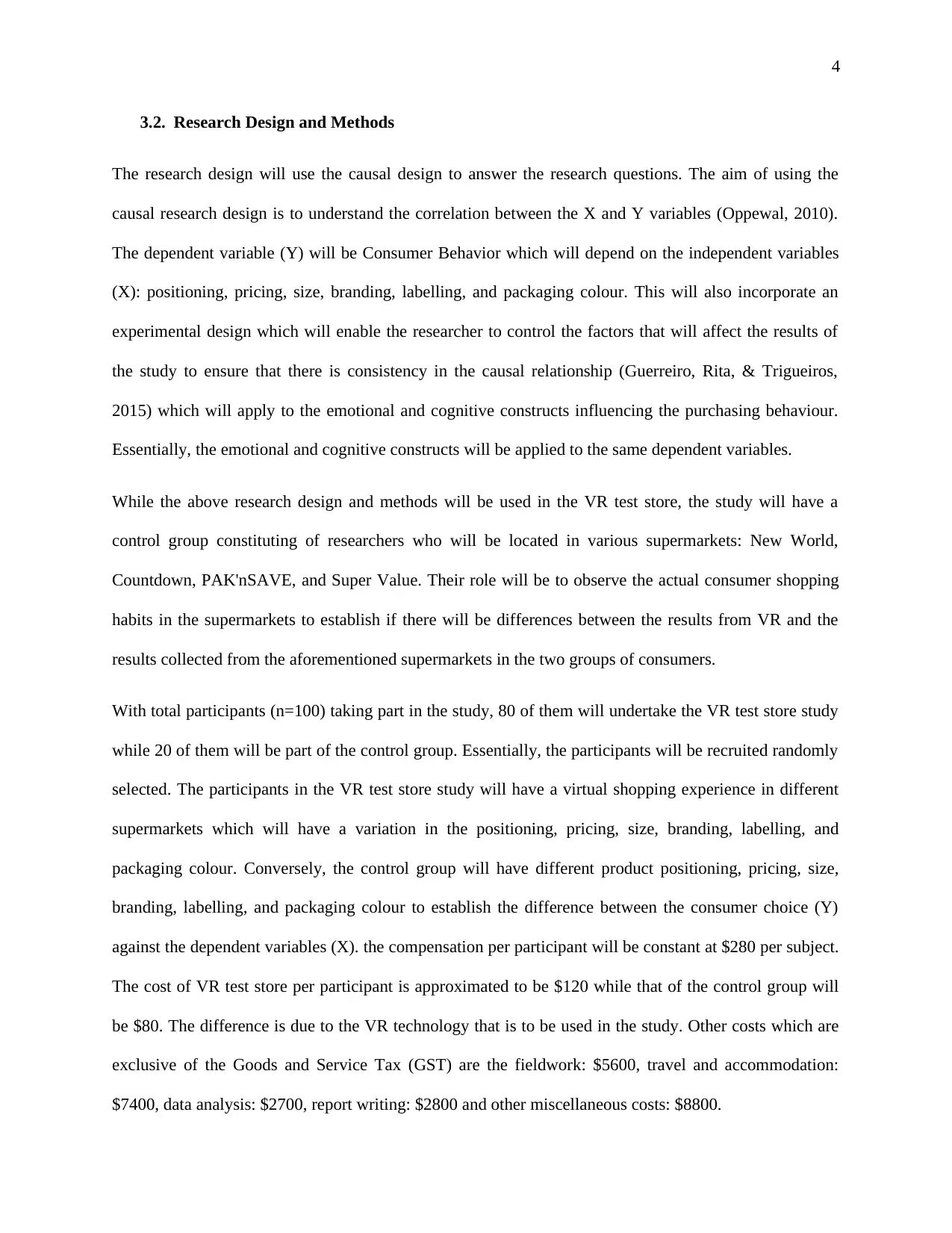
4
3.2. Research Design and Methods
The research design will use the causal design to answer the research questions. The aim of using the
causal research design is to understand the correlation between the X and Y variables (Oppewal, 2010).
The dependent variable (Y) will be Consumer Behavior which will depend on the independent variables
(X): positioning, pricing, size, branding, labelling, and packaging colour. This will also incorporate an
experimental design which will enable the researcher to control the factors that will affect the results of
the study to ensure that there is consistency in the causal relationship (Guerreiro, Rita, & Trigueiros,
2015) which will apply to the emotional and cognitive constructs influencing the purchasing behaviour.
Essentially, the emotional and cognitive constructs will be applied to the same dependent variables.
While the above research design and methods will be used in the VR test store, the study will have a
control group constituting of researchers who will be located in various supermarkets: New World,
Countdown, PAK'nSAVE, and Super Value. Their role will be to observe the actual consumer shopping
habits in the supermarkets to establish if there will be differences between the results from VR and the
results collected from the aforementioned supermarkets in the two groups of consumers.
With total participants (n=100) taking part in the study, 80 of them will undertake the VR test store study
while 20 of them will be part of the control group. Essentially, the participants will be recruited randomly
selected. The participants in the VR test store study will have a virtual shopping experience in different
supermarkets which will have a variation in the positioning, pricing, size, branding, labelling, and
packaging colour. Conversely, the control group will have different product positioning, pricing, size,
branding, labelling, and packaging colour to establish the difference between the consumer choice (Y)
against the dependent variables (X). the compensation per participant will be constant at $280 per subject.
The cost of VR test store per participant is approximated to be $120 while that of the control group will
be $80. The difference is due to the VR technology that is to be used in the study. Other costs which are
exclusive of the Goods and Service Tax (GST) are the fieldwork: $5600, travel and accommodation:
$7400, data analysis: $2700, report writing: $2800 and other miscellaneous costs: $8800.
3.2. Research Design and Methods
The research design will use the causal design to answer the research questions. The aim of using the
causal research design is to understand the correlation between the X and Y variables (Oppewal, 2010).
The dependent variable (Y) will be Consumer Behavior which will depend on the independent variables
(X): positioning, pricing, size, branding, labelling, and packaging colour. This will also incorporate an
experimental design which will enable the researcher to control the factors that will affect the results of
the study to ensure that there is consistency in the causal relationship (Guerreiro, Rita, & Trigueiros,
2015) which will apply to the emotional and cognitive constructs influencing the purchasing behaviour.
Essentially, the emotional and cognitive constructs will be applied to the same dependent variables.
While the above research design and methods will be used in the VR test store, the study will have a
control group constituting of researchers who will be located in various supermarkets: New World,
Countdown, PAK'nSAVE, and Super Value. Their role will be to observe the actual consumer shopping
habits in the supermarkets to establish if there will be differences between the results from VR and the
results collected from the aforementioned supermarkets in the two groups of consumers.
With total participants (n=100) taking part in the study, 80 of them will undertake the VR test store study
while 20 of them will be part of the control group. Essentially, the participants will be recruited randomly
selected. The participants in the VR test store study will have a virtual shopping experience in different
supermarkets which will have a variation in the positioning, pricing, size, branding, labelling, and
packaging colour. Conversely, the control group will have different product positioning, pricing, size,
branding, labelling, and packaging colour to establish the difference between the consumer choice (Y)
against the dependent variables (X). the compensation per participant will be constant at $280 per subject.
The cost of VR test store per participant is approximated to be $120 while that of the control group will
be $80. The difference is due to the VR technology that is to be used in the study. Other costs which are
exclusive of the Goods and Service Tax (GST) are the fieldwork: $5600, travel and accommodation:
$7400, data analysis: $2700, report writing: $2800 and other miscellaneous costs: $8800.
Paraphrase This Document
Need a fresh take? Get an instant paraphrase of this document with our AI Paraphraser
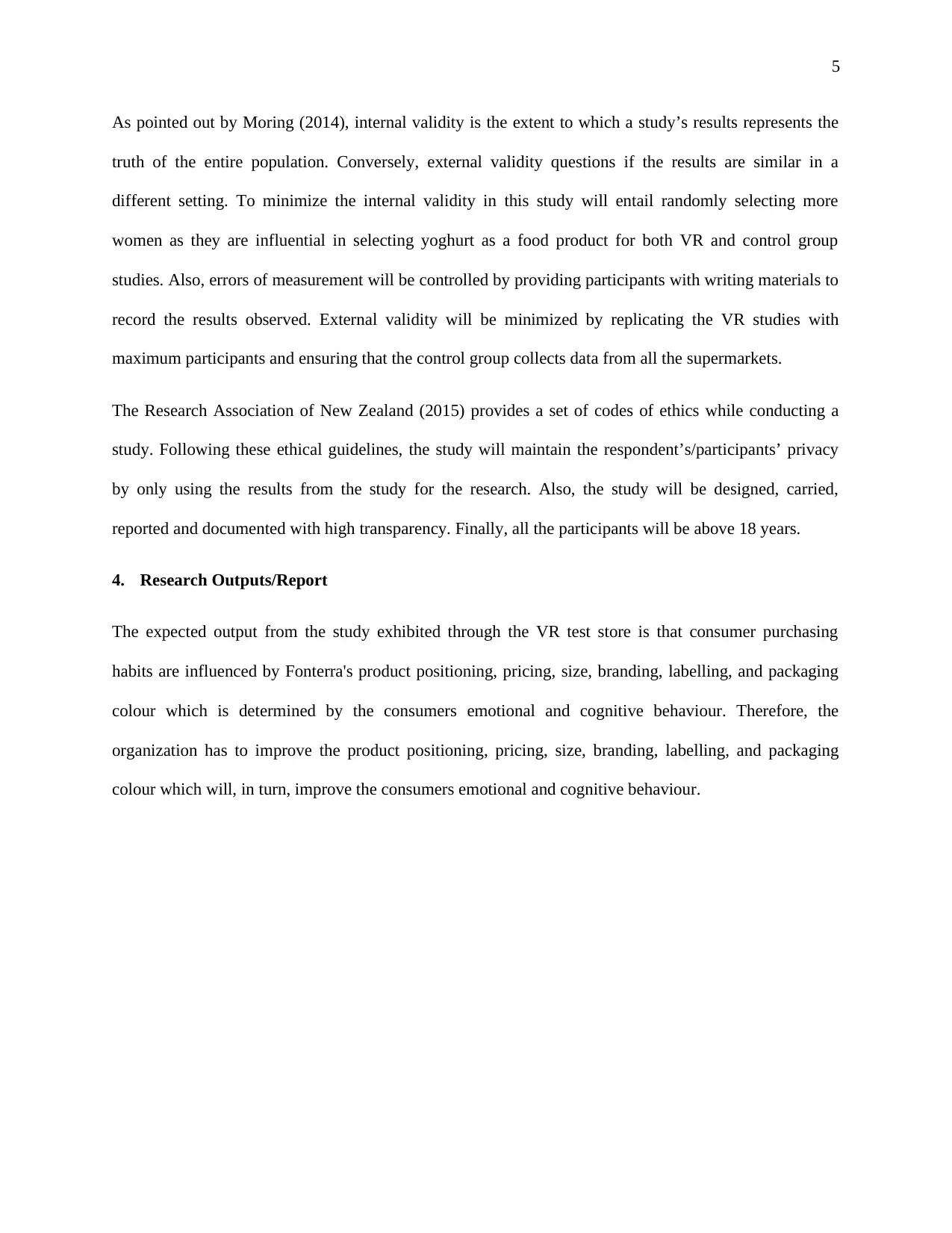
5
As pointed out by Moring (2014), internal validity is the extent to which a study’s results represents the
truth of the entire population. Conversely, external validity questions if the results are similar in a
different setting. To minimize the internal validity in this study will entail randomly selecting more
women as they are influential in selecting yoghurt as a food product for both VR and control group
studies. Also, errors of measurement will be controlled by providing participants with writing materials to
record the results observed. External validity will be minimized by replicating the VR studies with
maximum participants and ensuring that the control group collects data from all the supermarkets.
The Research Association of New Zealand (2015) provides a set of codes of ethics while conducting a
study. Following these ethical guidelines, the study will maintain the respondent’s/participants’ privacy
by only using the results from the study for the research. Also, the study will be designed, carried,
reported and documented with high transparency. Finally, all the participants will be above 18 years.
4. Research Outputs/Report
The expected output from the study exhibited through the VR test store is that consumer purchasing
habits are influenced by Fonterra's product positioning, pricing, size, branding, labelling, and packaging
colour which is determined by the consumers emotional and cognitive behaviour. Therefore, the
organization has to improve the product positioning, pricing, size, branding, labelling, and packaging
colour which will, in turn, improve the consumers emotional and cognitive behaviour.
As pointed out by Moring (2014), internal validity is the extent to which a study’s results represents the
truth of the entire population. Conversely, external validity questions if the results are similar in a
different setting. To minimize the internal validity in this study will entail randomly selecting more
women as they are influential in selecting yoghurt as a food product for both VR and control group
studies. Also, errors of measurement will be controlled by providing participants with writing materials to
record the results observed. External validity will be minimized by replicating the VR studies with
maximum participants and ensuring that the control group collects data from all the supermarkets.
The Research Association of New Zealand (2015) provides a set of codes of ethics while conducting a
study. Following these ethical guidelines, the study will maintain the respondent’s/participants’ privacy
by only using the results from the study for the research. Also, the study will be designed, carried,
reported and documented with high transparency. Finally, all the participants will be above 18 years.
4. Research Outputs/Report
The expected output from the study exhibited through the VR test store is that consumer purchasing
habits are influenced by Fonterra's product positioning, pricing, size, branding, labelling, and packaging
colour which is determined by the consumers emotional and cognitive behaviour. Therefore, the
organization has to improve the product positioning, pricing, size, branding, labelling, and packaging
colour which will, in turn, improve the consumers emotional and cognitive behaviour.
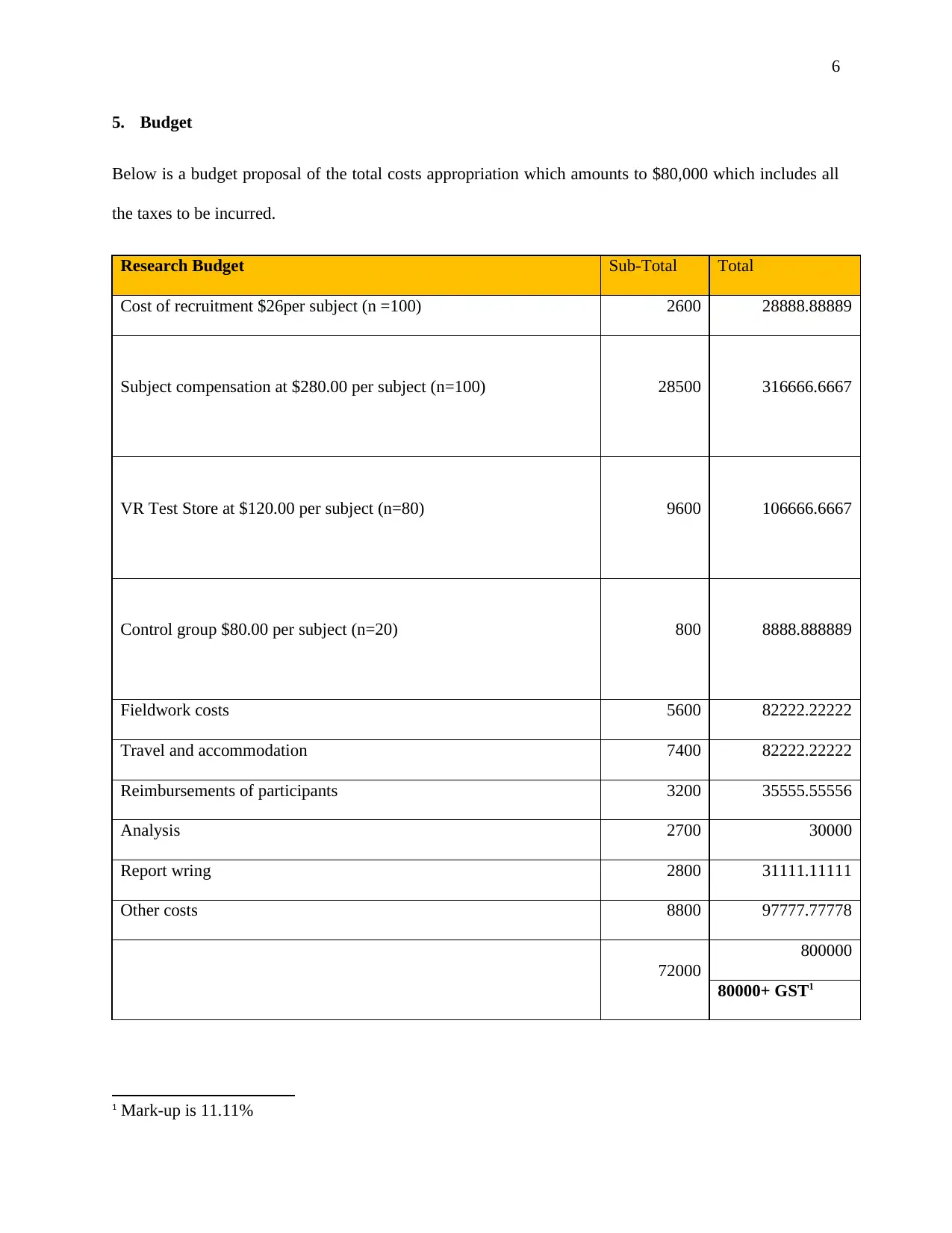
6
5. Budget
Below is a budget proposal of the total costs appropriation which amounts to $80,000 which includes all
the taxes to be incurred.
Research Budget Sub-Total Total
Cost of recruitment $26per subject (n =100) 2600 28888.88889
Subject compensation at $280.00 per subject (n=100) 28500 316666.6667
VR Test Store at $120.00 per subject (n=80) 9600 106666.6667
Control group $80.00 per subject (n=20) 800 8888.888889
Fieldwork costs 5600 82222.22222
Travel and accommodation 7400 82222.22222
Reimbursements of participants 3200 35555.55556
Analysis 2700 30000
Report wring 2800 31111.11111
Other costs 8800 97777.77778
72000
800000
80000+ GST1
1 Mark-up is 11.11%
5. Budget
Below is a budget proposal of the total costs appropriation which amounts to $80,000 which includes all
the taxes to be incurred.
Research Budget Sub-Total Total
Cost of recruitment $26per subject (n =100) 2600 28888.88889
Subject compensation at $280.00 per subject (n=100) 28500 316666.6667
VR Test Store at $120.00 per subject (n=80) 9600 106666.6667
Control group $80.00 per subject (n=20) 800 8888.888889
Fieldwork costs 5600 82222.22222
Travel and accommodation 7400 82222.22222
Reimbursements of participants 3200 35555.55556
Analysis 2700 30000
Report wring 2800 31111.11111
Other costs 8800 97777.77778
72000
800000
80000+ GST1
1 Mark-up is 11.11%
⊘ This is a preview!⊘
Do you want full access?
Subscribe today to unlock all pages.

Trusted by 1+ million students worldwide
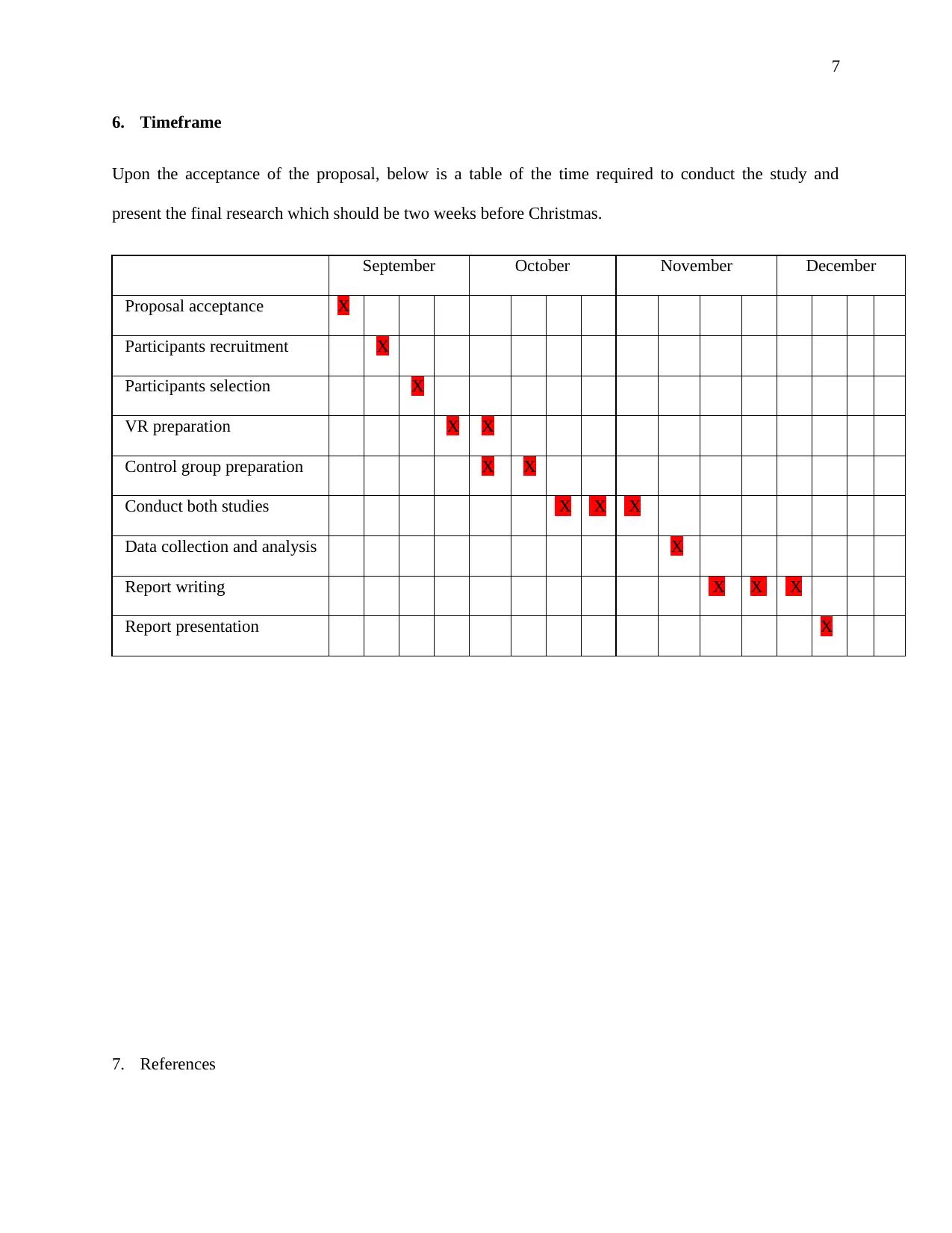
7
6. Timeframe
Upon the acceptance of the proposal, below is a table of the time required to conduct the study and
present the final research which should be two weeks before Christmas.
September October November December
Proposal acceptance X
Participants recruitment X
Participants selection X
VR preparation X X
Control group preparation X X
Conduct both studies X X X
Data collection and analysis X
Report writing X X X
Report presentation X
7. References
6. Timeframe
Upon the acceptance of the proposal, below is a table of the time required to conduct the study and
present the final research which should be two weeks before Christmas.
September October November December
Proposal acceptance X
Participants recruitment X
Participants selection X
VR preparation X X
Control group preparation X X
Conduct both studies X X X
Data collection and analysis X
Report writing X X X
Report presentation X
7. References
Paraphrase This Document
Need a fresh take? Get an instant paraphrase of this document with our AI Paraphraser
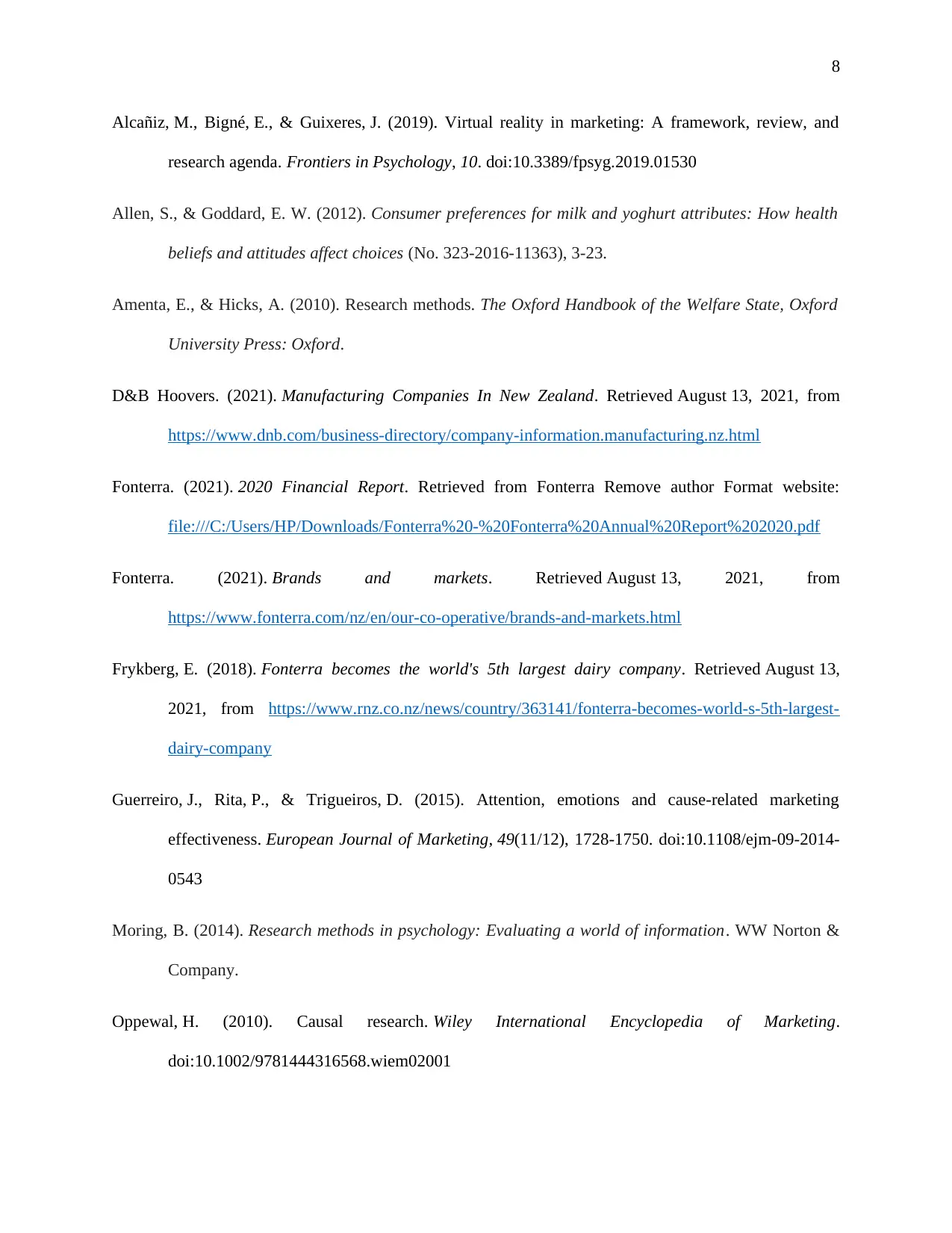
8
Alcañiz, M., Bigné, E., & Guixeres, J. (2019). Virtual reality in marketing: A framework, review, and
research agenda. Frontiers in Psychology, 10. doi:10.3389/fpsyg.2019.01530
Allen, S., & Goddard, E. W. (2012). Consumer preferences for milk and yoghurt attributes: How health
beliefs and attitudes affect choices (No. 323-2016-11363), 3-23.
Amenta, E., & Hicks, A. (2010). Research methods. The Oxford Handbook of the Welfare State, Oxford
University Press: Oxford.
D&B Hoovers. (2021). Manufacturing Companies In New Zealand. Retrieved August 13, 2021, from
https://www.dnb.com/business-directory/company-information.manufacturing.nz.html
Fonterra. (2021). 2020 Financial Report. Retrieved from Fonterra Remove author Format website:
file:///C:/Users/HP/Downloads/Fonterra%20-%20Fonterra%20Annual%20Report%202020.pdf
Fonterra. (2021). Brands and markets. Retrieved August 13, 2021, from
https://www.fonterra.com/nz/en/our-co-operative/brands-and-markets.html
Frykberg, E. (2018). Fonterra becomes the world's 5th largest dairy company. Retrieved August 13,
2021, from https://www.rnz.co.nz/news/country/363141/fonterra-becomes-world-s-5th-largest-
dairy-company
Guerreiro, J., Rita, P., & Trigueiros, D. (2015). Attention, emotions and cause-related marketing
effectiveness. European Journal of Marketing, 49(11/12), 1728-1750. doi:10.1108/ejm-09-2014-
0543
Moring, B. (2014). Research methods in psychology: Evaluating a world of information. WW Norton &
Company.
Oppewal, H. (2010). Causal research. Wiley International Encyclopedia of Marketing.
doi:10.1002/9781444316568.wiem02001
Alcañiz, M., Bigné, E., & Guixeres, J. (2019). Virtual reality in marketing: A framework, review, and
research agenda. Frontiers in Psychology, 10. doi:10.3389/fpsyg.2019.01530
Allen, S., & Goddard, E. W. (2012). Consumer preferences for milk and yoghurt attributes: How health
beliefs and attitudes affect choices (No. 323-2016-11363), 3-23.
Amenta, E., & Hicks, A. (2010). Research methods. The Oxford Handbook of the Welfare State, Oxford
University Press: Oxford.
D&B Hoovers. (2021). Manufacturing Companies In New Zealand. Retrieved August 13, 2021, from
https://www.dnb.com/business-directory/company-information.manufacturing.nz.html
Fonterra. (2021). 2020 Financial Report. Retrieved from Fonterra Remove author Format website:
file:///C:/Users/HP/Downloads/Fonterra%20-%20Fonterra%20Annual%20Report%202020.pdf
Fonterra. (2021). Brands and markets. Retrieved August 13, 2021, from
https://www.fonterra.com/nz/en/our-co-operative/brands-and-markets.html
Frykberg, E. (2018). Fonterra becomes the world's 5th largest dairy company. Retrieved August 13,
2021, from https://www.rnz.co.nz/news/country/363141/fonterra-becomes-world-s-5th-largest-
dairy-company
Guerreiro, J., Rita, P., & Trigueiros, D. (2015). Attention, emotions and cause-related marketing
effectiveness. European Journal of Marketing, 49(11/12), 1728-1750. doi:10.1108/ejm-09-2014-
0543
Moring, B. (2014). Research methods in psychology: Evaluating a world of information. WW Norton &
Company.
Oppewal, H. (2010). Causal research. Wiley International Encyclopedia of Marketing.
doi:10.1002/9781444316568.wiem02001
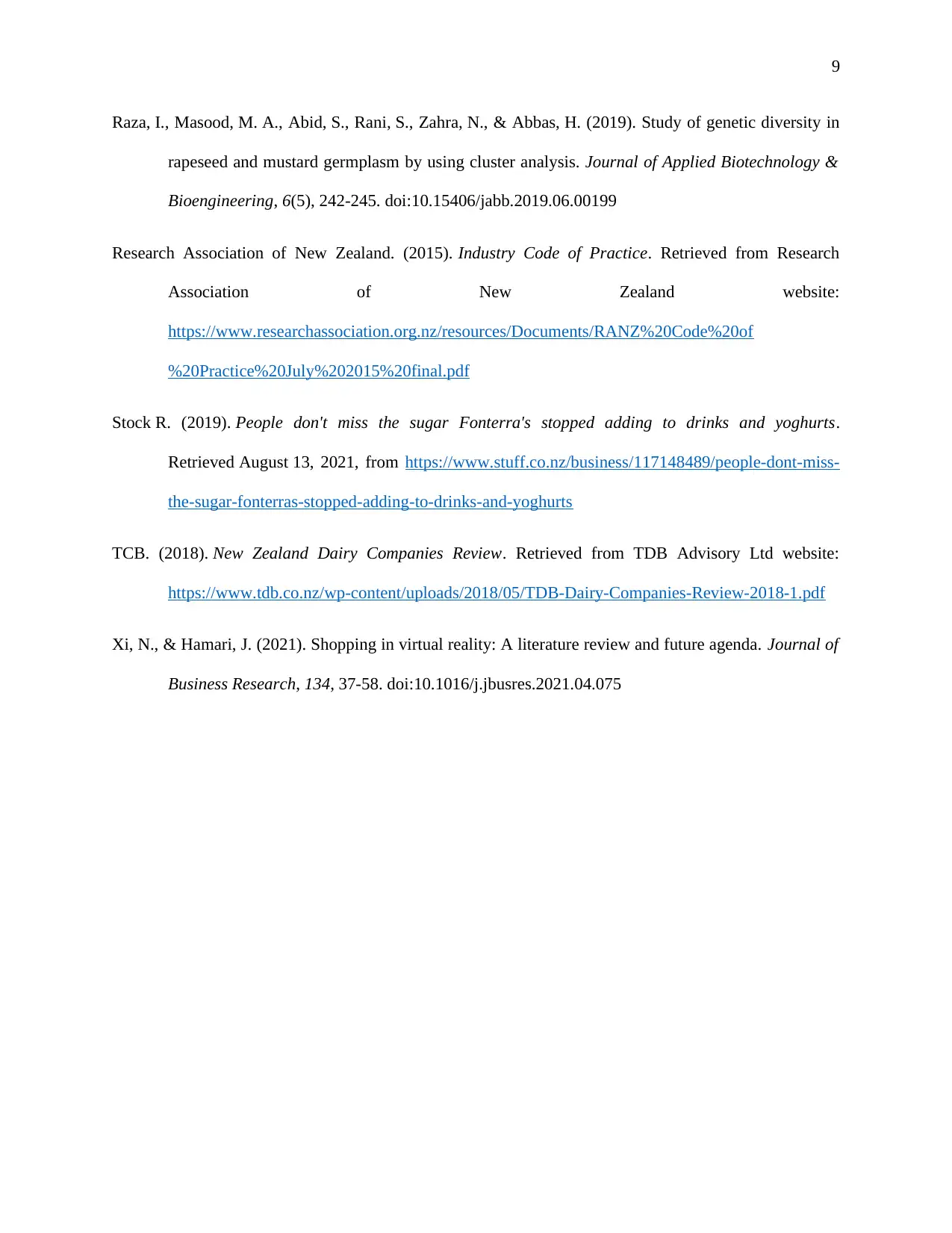
9
Raza, I., Masood, M. A., Abid, S., Rani, S., Zahra, N., & Abbas, H. (2019). Study of genetic diversity in
rapeseed and mustard germplasm by using cluster analysis. Journal of Applied Biotechnology &
Bioengineering, 6(5), 242-245. doi:10.15406/jabb.2019.06.00199
Research Association of New Zealand. (2015). Industry Code of Practice. Retrieved from Research
Association of New Zealand website:
https://www.researchassociation.org.nz/resources/Documents/RANZ%20Code%20of
%20Practice%20July%202015%20final.pdf
Stock R. (2019). People don't miss the sugar Fonterra's stopped adding to drinks and yoghurts.
Retrieved August 13, 2021, from https://www.stuff.co.nz/business/117148489/people-dont-miss-
the-sugar-fonterras-stopped-adding-to-drinks-and-yoghurts
TCB. (2018). New Zealand Dairy Companies Review. Retrieved from TDB Advisory Ltd website:
https://www.tdb.co.nz/wp-content/uploads/2018/05/TDB-Dairy-Companies-Review-2018-1.pdf
Xi, N., & Hamari, J. (2021). Shopping in virtual reality: A literature review and future agenda. Journal of
Business Research, 134, 37-58. doi:10.1016/j.jbusres.2021.04.075
Raza, I., Masood, M. A., Abid, S., Rani, S., Zahra, N., & Abbas, H. (2019). Study of genetic diversity in
rapeseed and mustard germplasm by using cluster analysis. Journal of Applied Biotechnology &
Bioengineering, 6(5), 242-245. doi:10.15406/jabb.2019.06.00199
Research Association of New Zealand. (2015). Industry Code of Practice. Retrieved from Research
Association of New Zealand website:
https://www.researchassociation.org.nz/resources/Documents/RANZ%20Code%20of
%20Practice%20July%202015%20final.pdf
Stock R. (2019). People don't miss the sugar Fonterra's stopped adding to drinks and yoghurts.
Retrieved August 13, 2021, from https://www.stuff.co.nz/business/117148489/people-dont-miss-
the-sugar-fonterras-stopped-adding-to-drinks-and-yoghurts
TCB. (2018). New Zealand Dairy Companies Review. Retrieved from TDB Advisory Ltd website:
https://www.tdb.co.nz/wp-content/uploads/2018/05/TDB-Dairy-Companies-Review-2018-1.pdf
Xi, N., & Hamari, J. (2021). Shopping in virtual reality: A literature review and future agenda. Journal of
Business Research, 134, 37-58. doi:10.1016/j.jbusres.2021.04.075
⊘ This is a preview!⊘
Do you want full access?
Subscribe today to unlock all pages.

Trusted by 1+ million students worldwide
1 out of 9
Your All-in-One AI-Powered Toolkit for Academic Success.
+13062052269
info@desklib.com
Available 24*7 on WhatsApp / Email
![[object Object]](/_next/static/media/star-bottom.7253800d.svg)
Unlock your academic potential
Copyright © 2020–2025 A2Z Services. All Rights Reserved. Developed and managed by ZUCOL.


